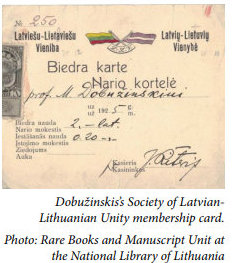
What do we know about painter Mstislavas Dobužinskis’s links with Latvia? According to philosopher Antanas Andrijauskas, before leaving for Western Europe Dobužinskis visited Riga with exhibitions [1]. What he did not mention was that the artist not only visited Riga, he lived there!
On 6 March 1924, opera “Eugene Onegin” featuring Dobužinskis’s scenography and costumes was performed in Dresden Opera. After the performance, the artist instead of Kaunas travels to Riga. While in Riga, he visits K. Bauls Photo-Studio located on Alexander St. 17 and orders a stack of photo postcards featuring his sets from the Dresden performance.
In the same year, Dobužinskis opened a huge personal exhibition in Riga’s City Art Museum (Pilsētas Mākslas Muzejs) featuring 170 works. Bibliographer Vytautas Steponaitis retained a tiny catalog of the exhibition written in two languages, Latvian and French: M. Dobužinska darbu izstāde: 1924–1925. Rīgas Pilsētas Mākslas Muzejā, Rīga: “Latvju Kulturas” Spiestuve, [1925].
Dobužinskis exhibited watercolours, oil paintings, lithographs, drawings and other graphics, mostly depicting Russia, especially St. Petersburg and Moscow. There were also Lithuanian motifs in the exhibition. For example, two Vilnius watercolours: “Old Church” (1902) and “Ruins of the Castle” (1912) and six recent paintings of Kaunas and Vilnius (1923).
At the beginning of 1925, the Lithuanian State Theater in Kaunas invited Dobužinskis to work on Pyotr Tchaikovsky’s opera “The Queen of Spades.” Most of the time, he stayed with Liudas and Bronislava Girai. It seems that the artist worked on opera’s costumes and scenography in both cities. Separate notes and sketches in Dobužinskis’s notebook attest to that.
The premiere which took place on 22 May 1925 was a great success. However, the Dobužinskis family did not intend to live in Kaunas, because of the shortage of apartments with amenities at the time. Besides, the artist felt the insincerity and jealousy of Kaunas intellectuals [3].
In 1925 Dobužinskis became a member of the Society of LatvianLithuanian Unity founded in Riga in 1921. He paid the entrance fee and the membership fee for a total of 2 lats and 20 santimi. On 16 of December 1925 the Lithuanian Consul in Riga Kazimieras Vizbaras asks Riga’s Prefecture to grant Dobužinskis, who was a citizen of the Republic of Lithuania, and his family a free visa to Lithuania.
Starting in 1926, Dobužinskis lives and creates in Western Europe. In 1929 the Dobužinskis family moves to Kaunas and spends a decade there. He also retains his connections with Riga and Latvia. In 1920s-1930s he gives public lectures in Riga: “The Italian Magnet (Italian Cult in European Art)” and “Art and the Mechanization of Modern Culture” [4].
In 1930 the second exhibition of Dobužinskis’s works takes place in Riga. It was accompanied by a catalog, M. Dobužinska darbu izstāde: Rīga: “Latvju Kulturas” Spiestuve, 1930. This exhibition is smaller than the first one, consisting of ‘only’ 61 works. Four of them are dedicated to Lithuania and Latvia: views of Jieznas and Skaruliai churches and Riga Old Town, and “House on the Embankment” [Mājas krastmalā].
A year later, in 1931, the editorial board of Latvian Encyclopedia (of Culture, Society and Education) asked Dobužinskis to fill in a questionnaire about his life and works. The questionnaire indicated the current Dobužinskis’s address: Maironio 5, Kaunas. Dobužinskis started to fill out the questionnaire before his work at the Lithuanian State Theater, because he refers to himself as a painter-artist and not a painter-scenographer. The card filled out by the editorial board specifies Dobužinskis’s profession in more abstract and precise way; it states that he is an artist (mākslinieks).
In 1931-1934, Dobužinskis studied Latvian ornaments and worked on combining Lithuanian and Latvian ornaments. He also created symbols for the Society of LatvianLithuanian Unity.
[1] http://tekstai.lt/zurnalas-metai/7147- antanas-andrijauskas-amziaus-dvasiapazinau-butent-cia?catid=743%3A2013- m-nr-01-sausis
[2] Воспоминания о Добужинском, составление, предисловие и примечания Г.И. Чугунова, СанктПетербург : Академ. проект, 1997, 1997, p. 281.
[3] Antanas Andrijauskas, Amžiaus dvasią pažinau būtent čia. Mstislavas Dobužinskis ir jo įnašas į Lietuvos dailės raidą. http://www.tekstai.lt/rss/743-2013-m-nr01-sausis/7147-antanas-andrijauskasamziaus-dvasia-pazinau-butent-cia